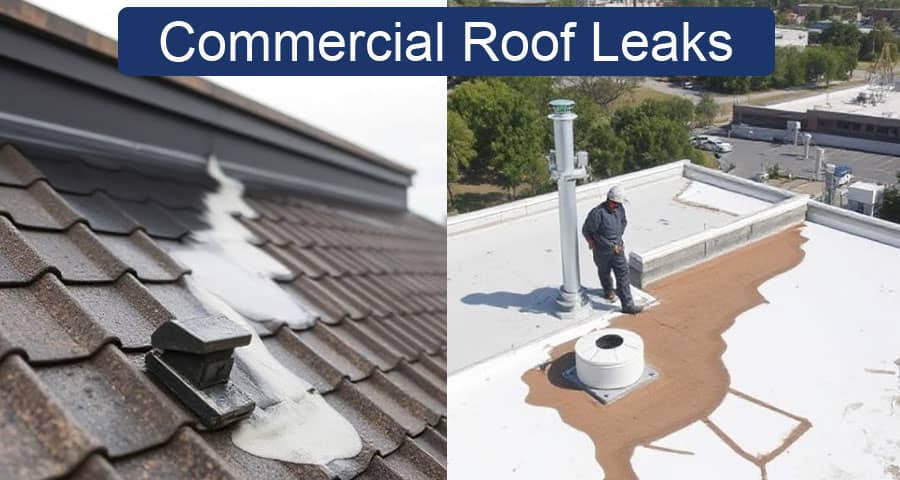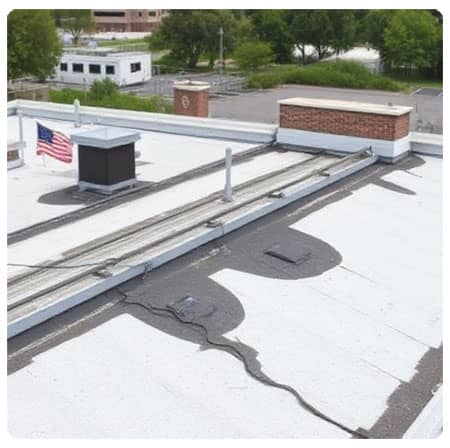What Are the Causes of Commercial Roof Leaks?

A commercial roof leak is more than a nuisance - it can result in significant property damage, disrupt business operations, and lead to expensive repairs. At its core, a leak signifies a failure in the integrity of a roofing system. Understanding the root causes of commercial roof leaks is essential for timely prevention, accurate diagnosis, and effective repair. Below, we explore in-depth the most frequent and impactful causes of leaks in commercial roofs.
1. Poor Roof Installation
One of the primary causes of commercial roof leaks is substandard installation. When a roofing system is not installed according to manufacturer specifications or industry standards, the likelihood of premature failure skyrockets.
- Inadequate sealing around penetrations like vents, HVAC units, and skylights can result in immediate vulnerabilities.
- Misaligned insulation or improperly secured membranes may allow water infiltration.
- Lack of slope in flat roof installations hinders drainage, increasing the risk of standing water and eventual leaks.
Professional installation by certified contractors is critical to ensuring long-term roof performance.
2. Aging Roofing Materials
Like all building components, commercial roofing materials have a limited service life. Over time, exposure to UV radiation, temperature fluctuations, and general wear and tear causes materials to degrade.
- Thermoplastic membranes (such as TPO and PVC) become brittle and crack over time.
- EPDM roofing systems may develop surface chalking or lose flexibility.
- Metal roofs are prone to rust and panel separation as fasteners loosen over decades.
Routine inspections can identify signs of aging before they escalate into active leaks.
3. Damaged or Clogged Drainage Systems
Water accumulation due to faulty or blocked drainage is a major contributor to commercial roof leaks.
- Clogged gutters, downspouts, and internal drains can cause water to pool on the roof surface.
- Over time, this standing water penetrates seams and low spots, degrading materials and insulation.
- Inadequate drainage design or neglect in maintenance exacerbates the issue, especially during heavy rainstorms.
Regular cleaning and inspection of the drainage system are essential to maintaining roof integrity.
4. Flashing Failures
Roof flashing is installed to seal and protect joints and edges where different parts of the roof meet. Improper flashing is one of the most common points of water entry.
- Flashing may lift, separate, or corrode due to weather or poor workmanship.
- When flashing fails around chimneys, skylights, or parapet walls, water easily infiltrates.
- Flashing that is not properly overlapped or sealed becomes a weak link in the system.
Using high-quality flashing materials and skilled labor minimizes this risk.
5. Membrane Punctures and Penetrations
Commercial roofs are frequently accessed for maintenance of HVAC systems, antennas, and other rooftop installations. This activity increases the risk of punctures or tears in the roofing membrane.
- Foot traffic, dropped tools, or heavy equipment can damage the membrane.
- Birds or pests can peck or claw at soft areas of the roof.
- Unprotected walkways or absence of paver systems contribute to accelerated wear.
Once compromised, even small holes can allow large amounts of water to enter the roofing assembly.

6. Weather-Related Damage
Severe weather is a relentless threat to commercial roofing systems. High winds, hail, snow accumulation, and intense UV exposure all take their toll.
- Wind uplift can loosen flashing and membranes.
- Hail impact may crack roofing surfaces or knock off protective granules.
- Ice dams formed during freeze-thaw cycles block drainage and trap water.
After major weather events, thorough roof inspections should be conducted to assess any latent damage.
7. Improper Repairs and Maintenance
Attempting to repair a commercial roof with inadequate materials or improper techniques can do more harm than good.
- Quick patches using incompatible substances may fail under heat or rain.
- Overlays that trap moisture can accelerate deterioration.
- Skipping maintenance schedules allows small issues to escalate into major leaks.
Preventive maintenance conducted by experienced professionals ensures the roof remains in optimal condition.
8. Roof Design Flaws
Sometimes, the problem starts at the design level. Roofs that are not engineered with water management in mind are inherently prone to leaks.
- Flat roofs with poor slope or drainage placement retain water.
- Inadequate expansion joints cause cracks as the building moves and shifts.
- Roofs with too many penetrations create a complex network of potential weak spots.
Architectural and engineering input during the design phase can mitigate future leak risks.
9. Thermal Movement and Expansion
Commercial buildings undergo thermal expansion and contraction due to daily and seasonal temperature changes. This constant movement stresses roofing materials.
- Seams can open as the materials expand and contract, especially if not installed with movement in mind.
- Flashing can pull away from walls and edges.
- Fasteners may back out or become loose, leaving entry points for water.
Roofs designed with proper movement tolerances and flexible materials fare better over time.
10. Vegetation Growth and Debris Accumulation
While green roofs are intentional and beneficial, unintended vegetation is problematic.
- Dirt, seeds, and moisture combine to support weed growth on neglected roofs.
- Roots can pierce membranes or clog drains.
- Accumulated leaves and debris trap moisture and encourage microbial growth.
Regular cleaning and roof hygiene are vital to preventing this kind of deterioration.
11. HVAC and Rooftop Equipment Leaks
Rooftop units like HVAC systems, exhaust fans, and solar panels often contribute to leaks.
- Improperly flashed equipment bases leak under storm conditions.
- Condensation from HVAC units may accumulate if not properly routed.
- Equipment movement during servicing can shift or damage surrounding materials.
Every rooftop penetration must be professionally sealed and regularly inspected.
Preventing Commercial Roof Leaks: A Proactive Approach
While understanding the causes of commercial roof leaks is crucial, implementing a proactive maintenance plan is the best way to mitigate these risks. This includes:
- Bi-annual professional inspections
- Timely cleaning of drains and gutters
- Immediate repair of minor defects
- Monitoring roof performance after storms
- Maintaining detailed service records
An ounce of prevention, in this case, is worth thousands in avoided water damage and operational downtime.
Please view the following short video for the Causes of Commercial Roof Leaks
